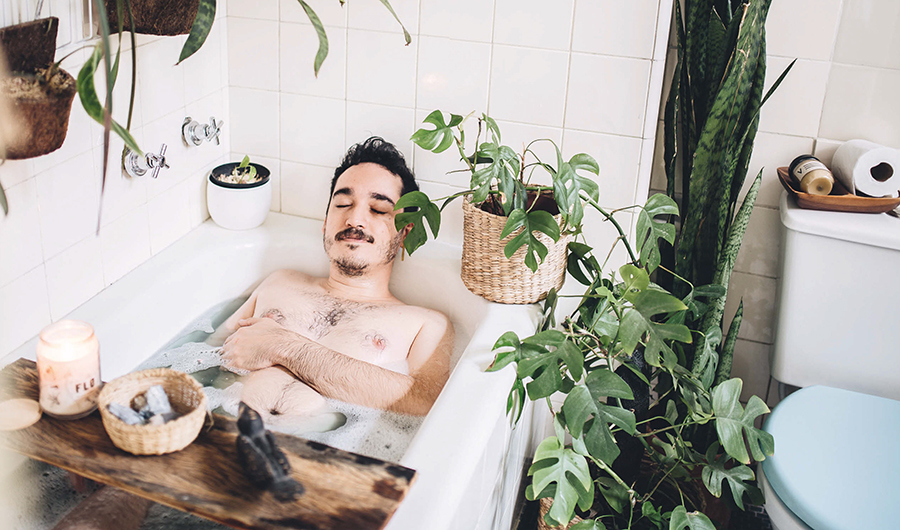
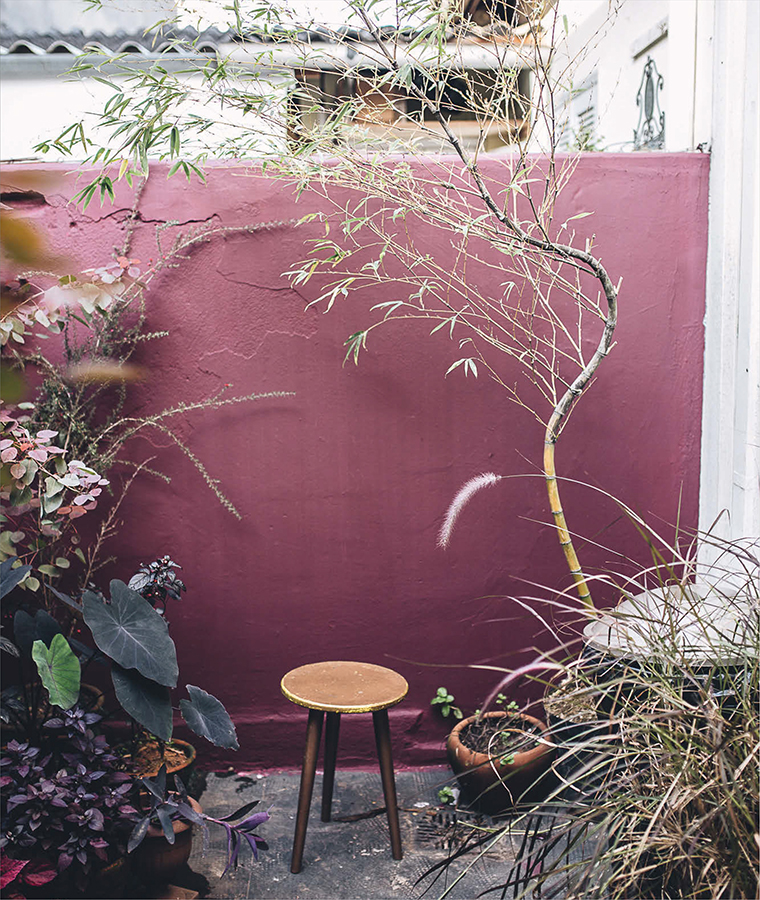
A serene plant oasis in the buzzing district of Pinheiros in São Paulo, Brazil.
chapter 4
WELL-BEING WITH PLANTS
As plant owners, we think mostly about how to keep our plants happy, by finding a watering routine and tending to them: fertilizing them, cleaning their leaves, and repotting them. Too often we forget that our plants return the good we do, in multiple ways. In fact, plants do much more for us than we do for them. To live with plants is to make a commitment to your own well-being. Whether we are conscious of it or not, plants lift our moods, help us unwind, feed our souls, and relax our bodies. In other words, a home filled with plants is a free spa for your body and soul, and your foundation for a good, healthy, and balanced life.
The mere presence of plants seems to exert a magic force over human beings—plants engage our minds, refresh our bodies and spirits; they position us firmly in the moment.
Our profound connection to nature is captured in the term “biophilia,” which is derived from the Greek words for “life” and “love.” It describes our love for nature and all living things. Oliver Sacks writes that “nature calls to something very deep in us,” and that biophilia is “an essential part of the human condition.” The restorative powers of plants have been known from the earliest days of humanity. So it’s only logical that in a modern home, too, plants will boost our well-being.
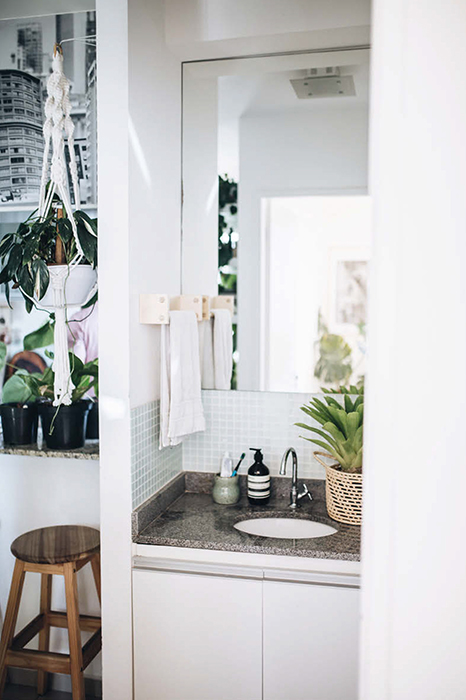
Take a moment out of your day just for you. Spend two minutes brushing your teeth while watching your plants, or relax in the presence of your houseplants.
4.1
plant ideas for your mind, body, and soul
Replenishing our minds, bodies, and souls can be simple. All we need to do is allow ourselves the time to unwind from the daily grind of our lives. And surround ourselves with plants of course. Here are a few ideas to help you improve your well-being.
TAKE A PLANT BATH
The practice of shinrin-yoku (forest bathing) was developed in Japan in the 1980s, and is today a cornerstone of preventive health care and healing in Japanese medicine. What works in a forest also works in your urban jungle at home.
To experience the soothing and balancing power of a plant bath, simply surround yourself with all your plants—the more the merrier. Find a moment when you’re grouping your plants together for plant care, or just take a seat (or, even better, lie down on a blanket or floor cushion) in the greenest corner of your home. Try to be fully encircled by plants—ideally, when you look up you’ll see some foliage, too. And now it’s really up to you! Do whatever relaxes you. You can simply sit in the midst of your plants, or read a book or a magazine, or sip a cup of coffee or tea. Give yourself fifteen minutes or even half an hour. Clear your mind of the daily buzz, switch your phone off, and focus on yourself and your inner balance. The plants will help you relax. Give it a try and trust your feelings. If you choose to sit quietly among your plants, see if you can focus on your breathing. Breathe steadily and calmly, and take deep breaths—inhale through your nose, exhale through your mouth. Fill your body with oxygen. The plants around you are producing fresh oxygen to restore your body and mind. Open up all your senses; tune in and experience every minute consciously. You’ll feel relaxed and balanced afterward. You’re then good to go and resume your busy schedule!
START A PLANT PROJECT
In addition to biophilia, Oliver Sacks writes about the human desire to tend and manage nature, which he calls “hortophilia.” Now, if you’re lucky enough to have a garden, go outside and practice hortophilia. Start a gardening project. Or if you have a balcony, how about beginning to grow some vegetables on it? If you have neither, start a windowsill plant project at home.
Why? Because tending to plants is utterly relaxing and comforting. It’s not a chore; consider it self-care and creative time for your imagination. A plant project helps take your mind off to-do lists, setbacks, and emotional roller coasters—trust us and give it a try. Your plants will be your best partners and friends, helping you clear your mind and getting you back on track. Simple plant projects you can make at home include building a terrarium, growing plants from seed, and growing new plants from cuttings. Use your imagination and do what makes you happy!

Creating a simple terrarium in a glass vessel can be both calming and rewarding. Here a little Begonia rex sits in a glass jar.
MEDITATE WITH PLANTS
Spending time with plants can have the same effect on our minds as meditation. So including a meditation practice among plants in your weekly routine will double the benefit. Here are a few ideas about how to meditate, and raise your level of mindfulness, in the company of your plants:
Breathing meditation
Sit surrounded by plants—in your home, garden, or balcony. Make yourself comfortable and look at your plants. Breathe naturally and take in the beauty of nature around you. If you wish, set a mantra for your meditation. Use a positive formulation, like “I am peaceful,” “I am loving,” “I am grateful,” and so on. Now close your eyes and focus on your breathing. Take a deep, full breath, inhaling through your nose; fill your stomach with oxygen first, and then your chest. Now exhale through your mouth, releasing the air from your stomach first, and then from your chest. Continue breathing in this way for a few minutes, until your body is fully revitalized with fresh oxygen (your plants will be producing that oxygen, by the way). Now return to breathing normally and let go of any thoughts. Be in the moment, feel your body, and be grateful for all the good things in your life.
Listening meditation
Take a seat among your plants, as in the breathing meditation. Keep your eyes open, however, and contemplate the shapes of the plants’ leaves and the tiniest details of their patterns and perforations; observe the plants’ stems, branches, and soil. As you do so, clear your mind of everyday chatter. Be mindful and present in the moment. You’ll feel invigorated after ten to fifteen minutes in silence with your plants. You’ll also be in good shape to start a round of plant care after your meditation.
Sketchbook meditation
This variation is especially for those of you who love to use your imaginations and who find inner peace and balance through activity. Follow the steps for the listening meditation, but now go one step further! Put your observations into words or sketches! Use a small sketchbook and get creative—write what you see, what you feel. Or draw the plants, the leaves, or whatever comes from your inner being. Let go of constraints and don’t judge whether the words make sense, or whether the sketch looks good. Just follow your inner voice and your intuition. Your writing or drawing is not the ultimate goal—what you seek is inner peace and balance. But, hey, if the end result is a nice plant poem or a quirky plant sketch—frame it and remind yourself that you’re always at peace among your plants!
Walk in nature
- Spending time in nature has long been considered beneficial to our overall well-being. Nature triggers a meditative state of mind and a greater sense of happiness. Imagine a sunny spring day in a forest or meadow and the array of flowers, colors, shades of green—who wouldn’t be caught smiling? Nature works its magic! But how is that? Nature has a way of demanding our full attention. It forces us to focus and look at what lies before us. In other words, when we’re in nature we become present. Allow time to take in the lush natural world around you; if you don’t have your own garden, head to your local botanical garden or a park. Awaken your senses by seeing, smelling, hearing, and feeling what is around you. Be mindful when walking in nature and come back home rested, balanced, and calmed—and at the same time invigorated.
- A recent study by Aarhus University, in Denmark, found that growing up in green surroundings lowers the risk of developing various mental disorders later in life by 55 percent. For more on Aarhus University, see https://international.au.dk/
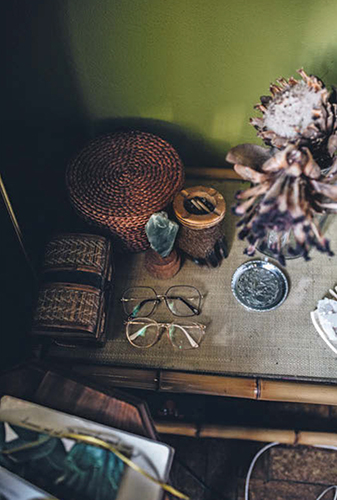
Surround yourself with personal items that have meaning to you. These will always enhance your inner balance and happiness.
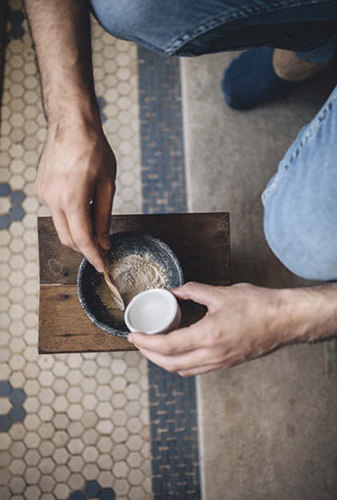
Renato (see this page) preparing a clay mask for a time-out moment in the plant-filled bathroom.

Ferns, pothos, and philodendrons are great choices for high-humidity areas such as bathrooms.

Lucas (see this page) and his plants enjoying a “plant bath.” He keeps humidity-loving plants such as Tillandsia, bromeliads, and philodendrons around the bathtub. This way they both enjoy a moment of well-being.
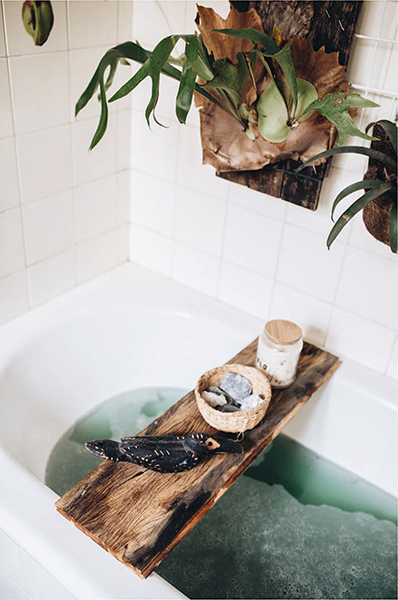
Mounted staghorn ferns above the tub are not only decorative but practical, too. The steam keeps the ferns humid and thriving.
ESTABLISH YOUR OWN PLANT RITUAL
There are all sorts of possibilities for plant rituals in your daily life, whether at home or outdoors (see chapter 1). Here’s a suggestion for your weekly routine: Create a green spa, for your ultimate timeout. We all know that a hot bath can work wonders after a stressful day. If you combine this with the power of plants, you’ll lift your spirits to unknown spheres. How? Simple as this: Even if your bathroom has no sunlight and you have no plants there, group a few leafy plants near the tub and then draw a bath. Tropicals, which love a high level of humidity, are best.
Add anything to your tub that makes you happy and relaxed—essential oils or dried flowers and plants. How about sage or mint leaves or rosemary sprigs from your balcony or kitchen? Add dried rose petals, orange blossoms, or marigolds. Do whatever pleases your senses. Also add a crystal or two—a rose quartz, amethyst, or apatite is ideal. Light a scented candle, if you like, have a glass of red wine or tea, and let your mind float and your senses unwind. Now enjoy your green spa, surrounded by plants—and you and they will benefit equally. The plants will calm you down and bring the soothing vibe of nature to your bathroom, and simultaneously enjoy the high humidity and warm temperature themselves. A win-win, and truly one of our favorite plant rituals at home.
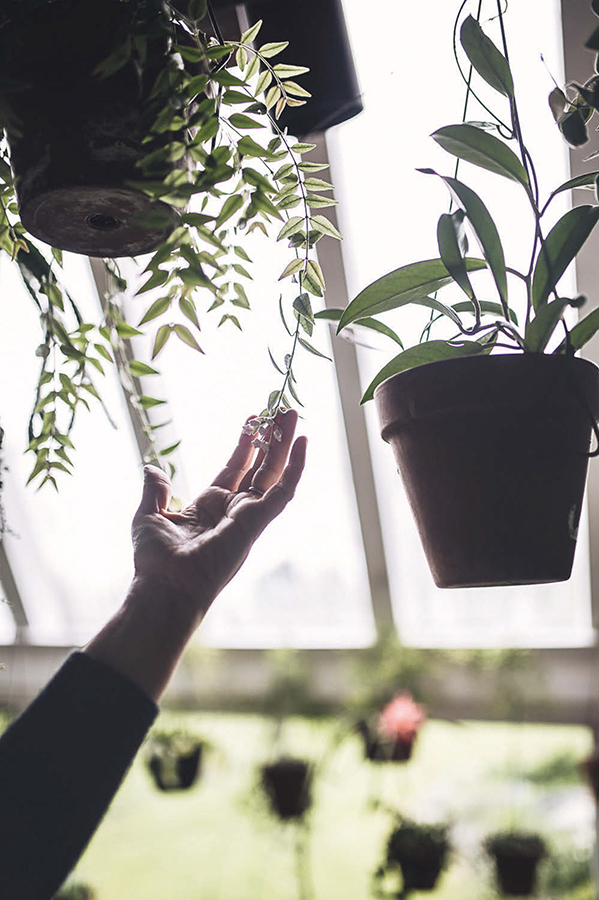
Plants have the ability to ground us and take the speed and buzz out of our daily lives.
4.2
slow living with plants
Nature in general and plants in particular are the best teachers of a slow, mindful way of living. Plants take time to grow; they’re not in a rush. They take time to develop strong roots and new leaves and stems; they bloom only when the season is right and the conditions are favorable. For us, appreciating this slowness is a first step toward embracing a slower-paced lifestyle. From plants we learn to be patient and to take one step after the other. Growing and thriving take time—for both plants and human beings. Today we need to remind ourselves more than ever of the importance of taking our time.
THE JOY OF MISSING OUT (JOMO)
“I’m busy!” When a friend asks us to meet for coffee, we have to check our schedules. Our phones are buzzing. And when they’re not, we’re catching up on the latest episodes of our favorite TV series while looking out for spoilers on social media. In other words, we’re constantly busy.
In these overconnected times, being busy and on top of it all is presented as the norm. We’re supposed to have picture-perfect lives (and picture-perfect plants, for that matter). And when we don’t, and we’re spending a Friday night on the couch scrolling through social media updates and seeing that everyone else is hanging out at a festival or tending to their thriving plants, we feel bad. It’s impossible for us not to want to be at whatever place some incredible thing is happening because we suffer from FOMO, the fear of missing out. And this fear is a serious threat to our well-being. Envy is the art of counting someone else’s blessings, instead of our own. And we don’t want that!
Choose to spend time by yourself, and create deeper relationships with your family members and friends, without the interruption of buzzing phones. Take things slowly and focus on what’s important in life. Since you’re a member of the Plant Tribe, one way you can spend time by yourself is in tending to your plants. How can plants help you with your slow living? Here are a few ideas:
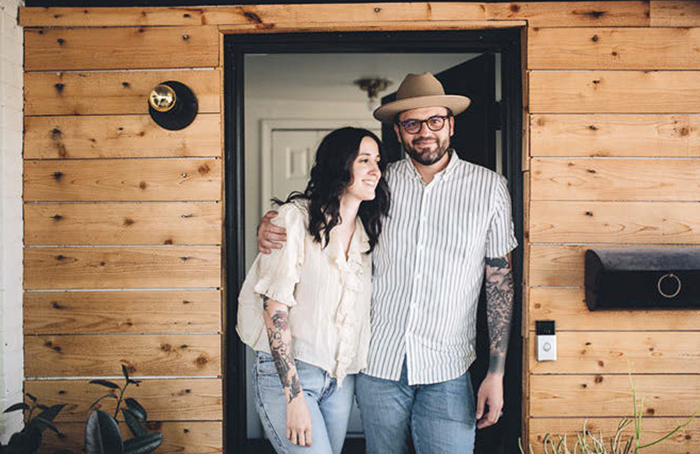
For your personal well-being, stay aware of social pressure and the feeling that you must accept every invitation to go out. Enjoy life with your loved ones and grant yourself those moments of joy and happiness at home.
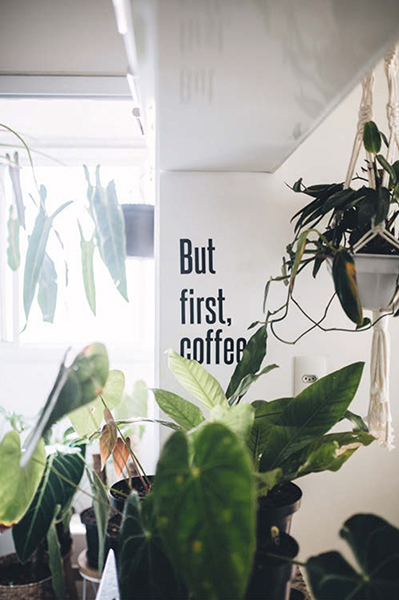
Sometimes you simply feel joy when staying in—just like Toy (see this page). A cup of coffee, a good book, and the company of your plants can be just a perfect alternative to any social event.
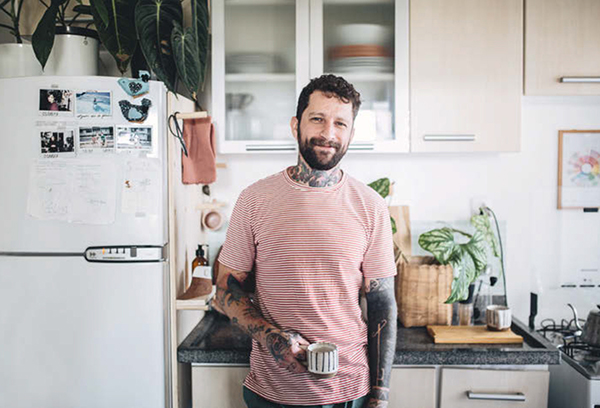
Care for your plants
Make your plant care routine a conscious exercise of patience. Don’t rush. Instead, carve out some extra time for you and your plants. Make it a weekly #MeMoment, with an hour dedicated to your well-being and that of your plants. Such a routine should leave both you and your plants happy, balanced, and relaxed.
Keep a plant journal
Writing in a plant journal can be beneficial in two ways: First, it assists you with your plant care and is a record of your plant growing process. Second, it helps you slow down. Take your time recording the names of your plants, their watering preferences, what soil they like, and the light conditions that are ideal for them. Note your successes as well as your failures in caring for them. By keeping a plant journal, you’ll not only learn more about your plants; you’ll also learn to consciously take your time.
Grow edibles
Whether it’s on your kitchen windowsill, on your balcony, or in a small garden, growing edibles is a deeply centering and rewarding exercise in slow living. Sowing seeds or seedlings, caring for them regularly, and finally harvesting the fruits of your labor is a long process, and cannot be rushed. Knowing how much time and effort went into growing the food on your plate will give you a profound appreciation of nature’s cycles. This resonates with our understanding of a good and meaningful life. The final result is not only a delicious homegrown meal but also the nourishing feeling of contentment. In other words, you are growing food for your body and for your soul.
Give yourself permission to live in the present. Be easy on yourself and treat yourself to a relaxing evening when you’ve had a bad day—or even when you’ve received good news: Take a moment to embrace it and celebrate accordingly. Enjoy social media–free time and unfollow people who trigger your FOMO or bring negativity into your life. Practice saying no.
Experiencing true happiness and treasuring every moment are what it’s all about. Prioritize your time and cherish JOMO, the joy of missing out.
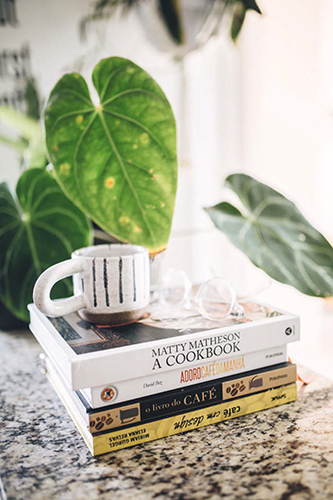
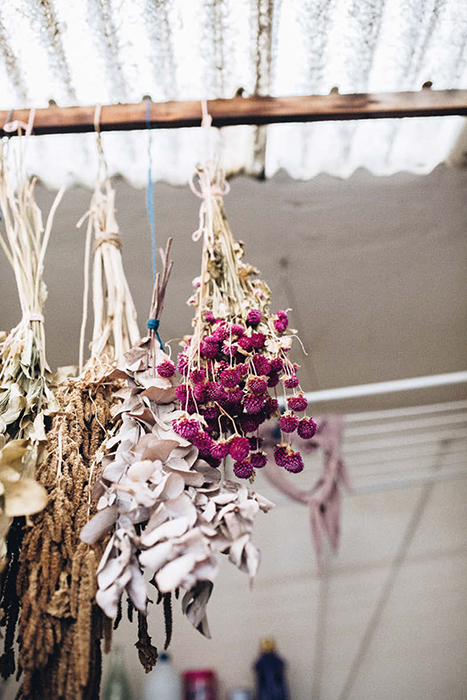
Dried herbs and flowers not only look decorative; some also have therapeutic properties and can serve as remedies for your own well-being.
4.3
horticultural therapy
As members of the Plant Tribe, we know subconciously that caring for plants helps us to be fully in the present. Even young children can benefit from mindfulness or meditation workshops in school, as their active lives, with a large variety of extracurricular activities and increased pressure to perform in a competitive environment, diminish their time and ability to just be kids. These workshops teach them to trust their instincts and to listen to their feelings, and give them time and quiet in which to gain self-confidence. Small plant projects, either in school or at home, can build on that foundation. Some of us may remember growing sunflowers, alfalfa sprouts, or papyrus plants in school—small biology experiments featuring foolproof and rapidly developing greenery that taught us the proper way to tend to plants. While some of us were hooked on growing greenery from early childhood, the majority of us lost touch with it. What a joy to (re)discover it as young-at-heart adults!
We referenced Oliver Sacks at the beginning of this chapter on the importance of gardens. This is especially the case when we’re going through a tough time, whether we’re suffering from a serious physical or mental health problem or “just” a heartbreak. Tending to plants is so powerful that it can be used in the process of healing.
Horticultural therapy combines the art and science of growing flowers, vegetables, fruits, and trees with the most current theories of human behavior, neuroscience, and psychotherapy. Through gardening activities, horticultural therapists seek to enhance patients’ social, cognitive, and physiological functioning, with the primary goal of improving health and inspiring motivation for change. By placing patients in caregiving roles—for example, by having them plant vegetables in a garden or propagate plants from a hospital bed—the therapists are able to create experiential environments that are both growth-focused and life-affirming.
HEALTH BENEFITS OF TENDING TO PLANTS
Horticultural therapy can help in the treatment of many health issues, such as:
- PTSD
- Eating disorders
- Physical rehabilitation
- Improvement of fine motor skills
- Pain
- Memory improvement
- Task initiation
- Language skills
- Socialization
In a hospital, where everything is stressful and attention is often focused on the physical health of the patient, tending to a plant allows a complete change of perspective. The patient is no longer the object—the plant is—and this gives the patient space to heal and focus on aspects of the recovery process that doctors may overlook. Bringing nontoxic plants and soil into a sterile hospital environment can be tricky, but the sanitary risks are minimal when there are clearly established procedures for staff and patients.
Take care of your own well-being and health; look to nature for inspiration and for the knowledge that a good and healthy life is not one of rushing and grabbing all opportunities. It’s one that is based on growing steadily and quietly, with patience and contentment. It’s one nourished by the simplest ingredients: love, light, and natural food. Stay healthy, stay happy, and take care of your plants! They’ll reward you many times over!
plant tribe stories . . .
Olive May
“Plants transformed my life; they opened so many doors for me!”
Location
Dallas, Texas, USA
Profession
Teacher, educational consultant
Zodiac
Virgo
Lives with
Husband Rudy and dogs Mylee and Fender
House size
3,000 square feet / 278 square meters
Favorite plant
Ficus benjamina
Plant decor idea
Add character and fun to your plants with artsy-looking head-shaped planters, or planters with faces.
Number of plants
350
@oliveinwanderland
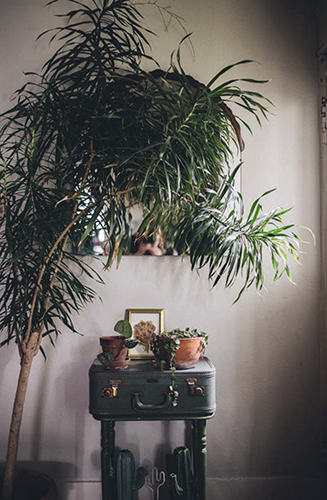
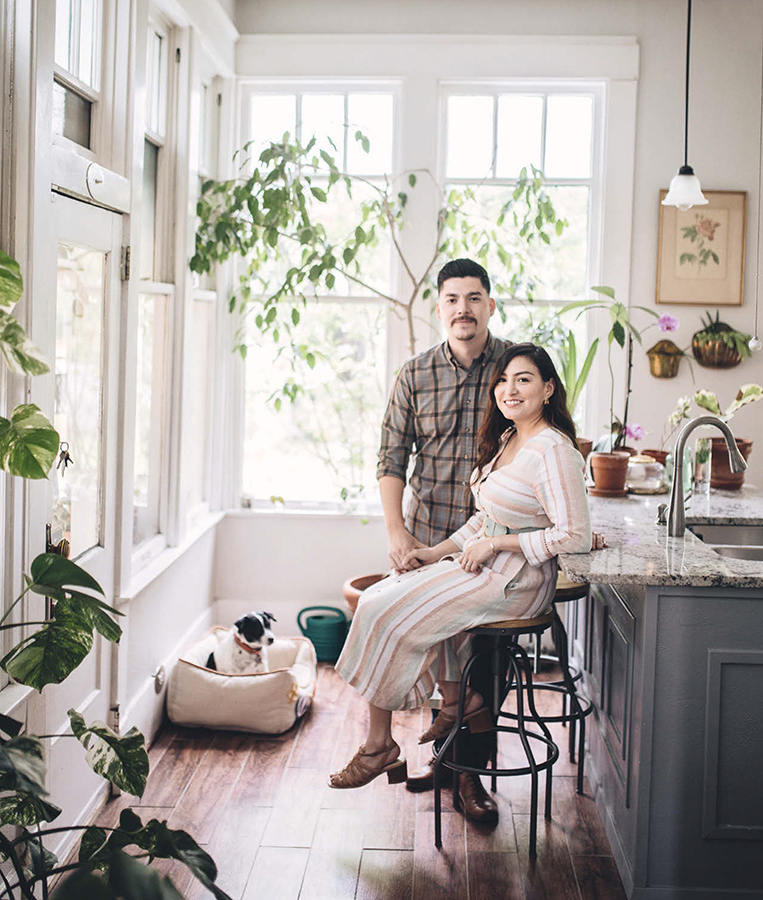

Olive and Rudy live a happy life and are proud Texans.
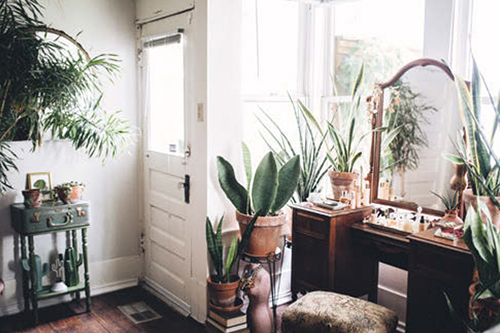
Olive’s beauty corner in her bedroom is lush and green with snake plants and a tall Ficus alii.
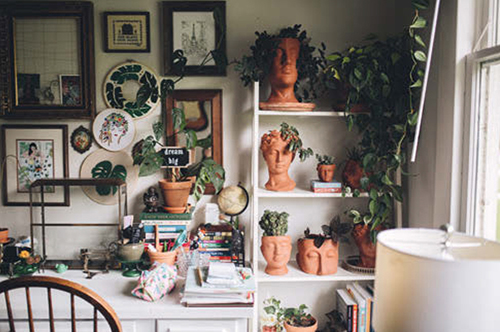
Use similar planters, like this collection of “face pots,” to create a striking vignette.
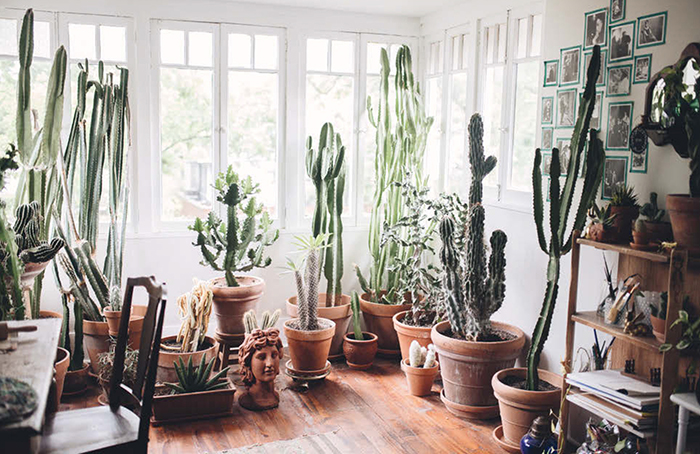
Olive’s sunroom is filled with cacti and succulents enjoying all-day sunshine.
A spacious house in a peaceful residential area of Dallas is home to Olive and Rudy, a teacher couple who have been together since their teens. These high school sweethearts love to work on their home, and they have renovated steadily to transform it into an artistic haven. Houseplants can be found in every corner, and now—more than 350 plants later—they are still making space for a few more. “Estate sales are a great way to find mature plants for a reasonable price. Or check local nurseries and Facebook Marketplace in your region for good plant deals,” Olive advises.
Olive’s love for plants is inherited from her mom, who owns an even bigger collection. At one point, when their communication was strained, Olive would reach out to her mom for plant advice. This strengthened their relationship, and their bond grew with each plant Olive added to her collection. Today, her mom happily acts as plant sitter whenever the couple is away. “Caring for plants has been a revelation: They have helped me overcome anxiety and have taught me to be more patient. I don’t worry so much about myself when I care for plants. They have helped me heal, for which I’m very thankful.”
Plants have also led Olive to the discovery of new creative outlets, like painting and pottery. Olive wanted unique planters for her green friends and began making lighthearted head-shaped planters that are now displayed all over the house. “Recently I visited a succulent grower in Austin and they asked if I could make some head planters for their shop, too! The love for plants has connected me to amazing like-minded people.”
Saturday mornings are reserved for a weekly plant check—and the cactus room gets special attention on the first and fifteenth of the month, when its inhabitants are watered. “I once bought a beautiful old cactus from a guy who wanted four hundred dollars for it but eventually sold it to me for much less because he wanted the plant to be in good hands and keep thriving. Plants are worth more than money.”
And we can only agree.

Olive is a creative soul and derives lots of inspiration from her plants.
plant tribe stories . . .
Lucas Midio
“There are no ugly plants—people just don’t know enough about them.”
Location
São Paulo, Brazil
Profession
Freelance game artist, plant consultant
Zodiac
Gemini
Lives with
Partner Renato and dog Nuno
Apartment size
1,290 square feet / 120 square meters
Favorite plant
Vriesea saundersii
Plant decor idea
Use branches and natural materials to hang plants. Group plants according to their natural habitat (mountain, desert, jungle) or by shape (rosettes, spiky plants, and so on).
Number of plants
Approximately 100
@mi.di.o @renato.apf
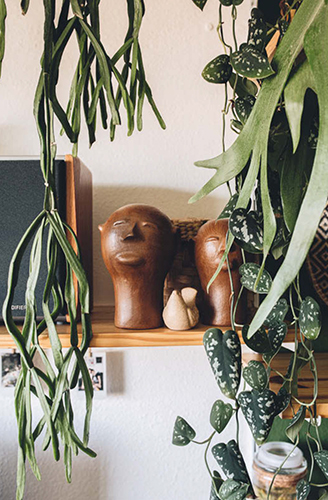
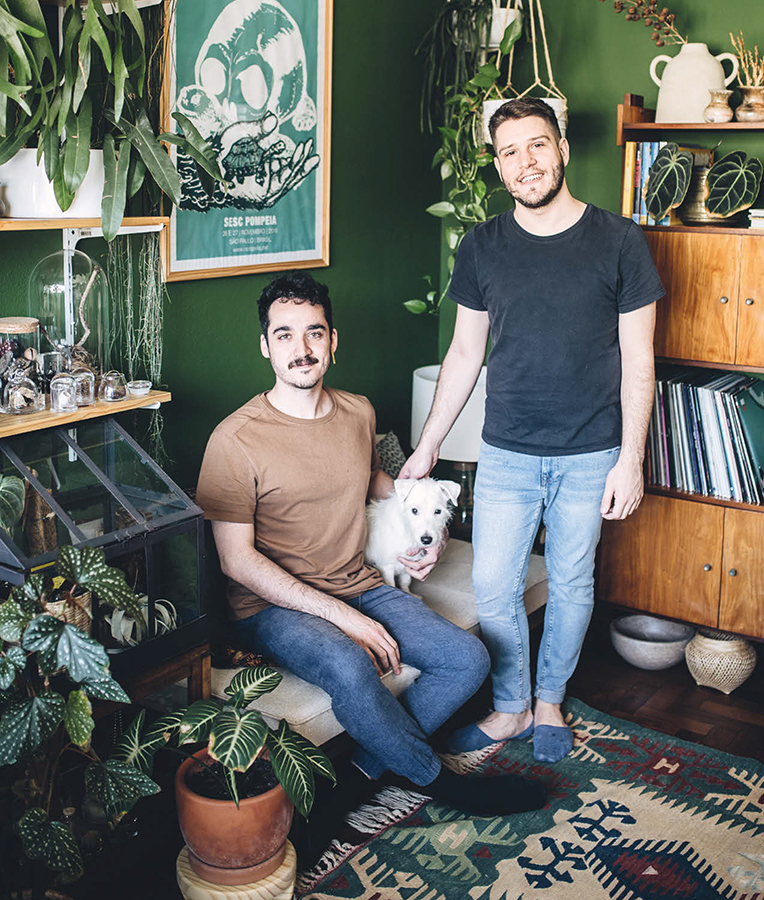
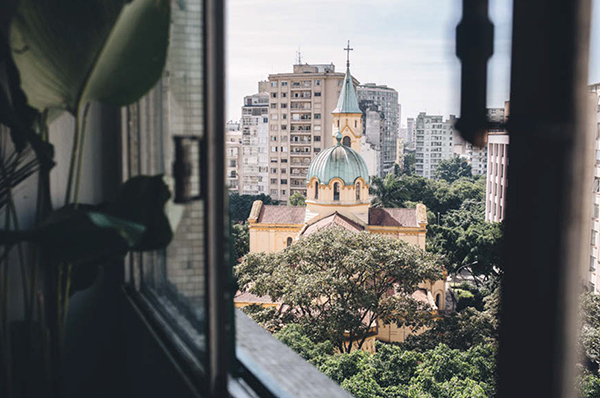
View out of Lucas and Renato’s apartment at the Santa Cecília church in the namesake São Paulo neighborhood.

Lucas and Renato love plants, midcentury design, vintage finds, and indigenous craftsmanship from Brazil. But above all, they love their dog, Nuno.

A vintage tapestry sets the tone in the warm, ochre-colored bedroom.

Lucas has a talent for creating plant stylings with vintage ceramics and tribal art, while Renato is a passionate vinyl collector.
São Paulo’s buzzing Santa Cecília neighborhood is home to cool bars, delicious restaurants, Friday-night samba performances on the street, and the beautiful urban jungle of Lucas and Renato and their dog, Nuno. Their spacious flat overlooks Santa Cecília’s central square and charms visitors with worn and beautiful details: old tiles in the bathroom and on the balcony, a lived-in and beautiful wooden floor, carefully curated midcentury furniture, and an earthy color palette. Throughout the warm and inviting home are rich details such as Brazilian folk-art objects, woven baskets from Amazonas, jugs from Minas Gerais, and wooden figurines made by indigenous tribes. Of course, another thing that captures attention is the abundance of plants—most of them native to Brazil, a particular passion for Lucas.
“Whenever I head out to buy one plant, I come back with at least three,” says Lucas with a smile. At the beginning of their life together, Renato was less at ease with the abundance of plants. “At the beginning, the plants seemed like objects that often were in the way,” confesses Renato. Today, both Renato and Lucas agree on how much the plants contribute to their well-being, and their sense of home.
Lucas’s love for plants began during his childhood in the countryside of Brazil. He fondly remembers joyful days in the Atlantic Forest, playing among bromeliads, philodendrons, orchids, epiphytes, ferns, and other tropical plants. A lot of plant knowledge was passed to him by his grandmother, who was a real expert of the local flora. Lucas recalls, “When I was a teenager, I wanted to escape all that and be a big city boy. It wasn’t until I came to São Paulo that I felt something was missing in my life. Adding plants to my home was a way to reconnect to my family and my roots.”